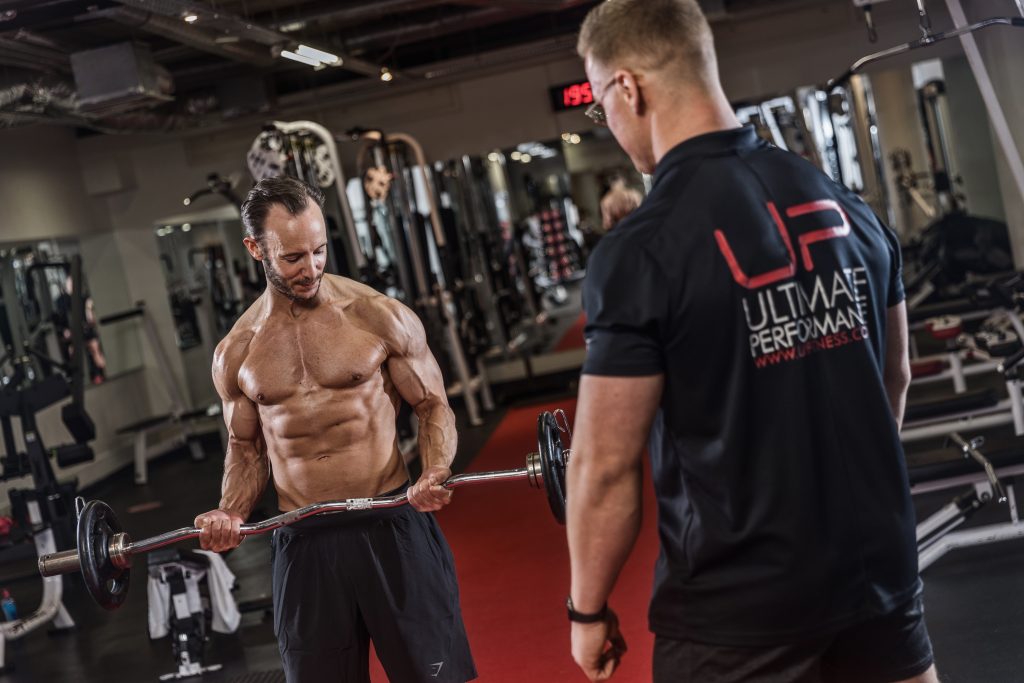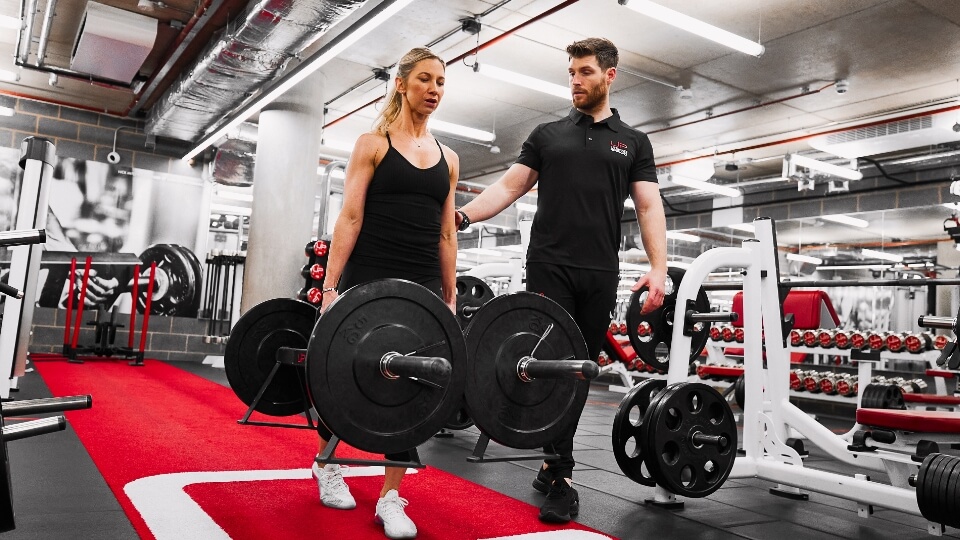The benefits of resistance training as you get older are truly astounding.
If you’re looking to slow down ageing and stay younger and vibrant through your 40s, 50s, 60s and well beyond, then science shows again and again that resistance training with weights is vital.
Improved brain function, health, metabolism, blood sugar control and overall decreased risk of all-cause mortality are just some of the headline benefits of lifting weights we discussed in-depth in Part 1.
But here we take this potentially life-changing scientific knowledge a step further and show you how we create training programs with hundreds of clients over 40 at UP to get them in the best shape of their lives.
When we read about the ‘inevitable’ onset of sarcopenia and how we will waste away as we approach our middle ages, we call B.S.
We have seen too many cases of middle-aged clients building muscle and losing fat at rates equal to, sometimes even better than our younger clients, to know this is not true.
A look at some of the transformations scattered through this four-part series are clear-cut evidence.

Mike proves that results can be equal to, or even better than those in his 20s. Read his Story here
So how do we train clients in their 40s, 50s and beyond?
When we encounter clients in their 40s and 50s, their goals are almost always different to those in their 20s and early 30s.
The latter often come in with one goal on their mind, a complete physique transformation.
For our middle-aged clients, aesthetics is still on their mind, as remember at UP, we specialise in body composition.
However, other goals such as strength, mobility, and health also become increasingly important, and this needs to be taken into account when devising our programs.
The fact is, our middle-aged clients want to look good, but also feel a hundred times better than they did in their 20s and early 30s, which is where their lifestyle choices left them in a physical and physiological mess.
That being said, whether someone is a complete beginner or an advanced trainee, here are 10 things that are highly applicable to this age group.
1. Staying injury free
Picking up a niggle when you’re in your 40s will take a lot longer to recover from than when in your 20s, and so avoiding this will keep you training for longer, meaning a more frequent stimulus for growth, and ultimately more muscle.
Keeping yourself healthy should be a number one priority, no matter what your age group. But trainers should always remember that dropping the intensity stimulus in a middle-aged client will affect them a lot more than a younger client.
A frequent stimulus is the most important consideration for older people, so it is key to not miss out on vital training time.

Find out how 46-year-old Nurani got his dream six-pack in just 18 weeks training with UP.
2. Incorporate lots of variety in training
One of the most important variables in hypertrophy, whilst avoiding the ‘niggly’ over-use injuries so prevalent as you age, is to incorporate lots of variety in your training.
For middle-aged clients, rotating through exercises with different implements and strength curves can be a good way to stay healthy and strong.
Variety should not just be limited to exercise choice, but also exercise order. Although a slightly more advanced technique (once you learn the concept of keeping tension on a muscle), placing more stressful exercises such as squats and barbell bench presses towards the end of a workout means you can create a similar training effect albeit with less load.
3. Spend more time in ‘accumulation’ phases
As you age, periodization becomes more important – organising your training into blocks where you alternate or linearly move from accumulation (muscle growth) and intensification (maximum strength) phases is a great idea.
For the older clients, keeping the ratio of accumulation to intensification at 2:1 or 3:1 would be wise, as their joints will not be as well suited to intensification protocols.
Traditionally, intensification phases would emphasise repetition brackets of 1 to 6.
For over 40s, using one of these phases every 3 to 4 cycles, going no lower than 4 to 6 reps would be wise.

4. Increase your time under tension
Building on the previous point, one of the best ways to train as you age is to find ways to increase time under tension on your muscles and the difficulty of exercises.
Besides adding reps, experimenting with different styles of tempos (pauses, slow eccentrics, controlled tempos etc.) is highly effective in reducing joint stress, providing a different stimulus, and creating a greater muscle-building stimulus.
Another concept, briefly introduced in our previous article, is the use of low-load, high-rep training close to technical failure.
This is of particular relevance to older people, as they can utilise low loads (even something like resistance bands) to provide an introduction to resistance exercise, whilst also generating an anabolic stimulus and the beneficial impact it will provide.
5. Reduce frequency of spinal loading
Grouping lower back-intensive exercises into one day a week can be a great way to allow recovery for the often-vulnerable lower back structures.
If training the legs every three to five days, an example rotation could be to do a squat or deadlift variation one workout, and train predominantly with unilateral and machine exercises on the next, before going back to a squat or deadlift workout.
On this note, squats and deadlifts may not be necessary at all in their true form if you are a beginner with no movement capability, as this will often do more harm than good.

Read how company president Grace fit weight training into her busy schedule
6. Stabilise
When encountering new trainees in their 40s and 50s, one of the key issues we see at UP is a lack of stability in their joints. So, utilising isometrics, unilateral work and slow tempos initially can help bring up this vital aspect of fitness.
7. Focus on quality
Often with beginner clients above 50, in particular, focusing on perhaps four to five exercises per workout at the maximum is all that’s needed.
Simply picking an upper body ‘push and pull’ session, and lower body ‘push and pull’, rotating, and keeping an eye on quality is an excellent way to train.
8. Warm up, mobilise and stretch
Spending 10 to 15 minutes a day on mobility and flexibility will pay huge dividends when it comes to staying healthy as you age.
For clients in their 40s and 50s, this is critical as the ability to ‘get away with’ poor posture and technique diminishes, so the need to be warm and pliable prior to, and during training, is enhanced.

Click HERE to download this collection of FREE advanced UP workouts
9. Utilise conditioning
Cardiovascular health is always important and is a growing concern amongst anyone over 40.
As stated previously, improving work capacity will enhance the sensitivity of the muscle hypertrophy signalling pathways.
Staying ‘fit’, therefore, whether it be through improving density of resistance training, or adding further conditioning sessions, is very useful for middle-aged trainees.
10. Keep active and enjoy it
Simply staying active outside of the gym is vital, and often overlooked.
A daily walk can play huge dividends on improving many of the factors that contribute to anabolic resistance – the muscle’s reduced ability to respond to an anabolic stimulus which worsens as you age.
So finding an activity and sport you love and can enjoy with others will keep you active for decades, and help just as much as the three hours in the gym can.

Smart training can keep you looking sharp into your 50s.
What about training specific recommendations for clients with andropause and menopause symptoms?
Whilst resistance training as a whole will benefit the conditions discussed, there are some subtle specifics that can lead to faster improvements.
Generally, the differences in training are not significant, as a strong focus on the above 10 principles will lead to vast improvements themselves.
Training and Menopause in Women

However, with menopause, the devil is in the detail. As we know, there is a decline in the ovarian production of oestrogen and progesterone, which act as ‘controls’ for cortisol and insulin.
It is often the case that in these women, they will be more stress-sensitive, and as such, this should be factored into their exercise regime.
During intense and long-duration exercise, cortisol is produced. In order to produce a positive adaptive response to exercise, cortisol is necessary and very beneficial.
During resistance exercise in particular, the rise in anabolic hormones in combination with cortisol provide a very healthy and beneficial response, whereby the body will work to lose fat and build muscle.
However, many women fall into the trap of partaking in too much long-duration exercise, in the hope that doing lots of repetitive motion will lead to more calories expended and more fat loss.
The ‘calories in/calories out’ equation is fundamental to weight loss, but for these women in search of body recomposition, we must look at it from a slightly different angle, whereby we balance out the often ‘off the rails’ hormonal system.
Therefore, shorter intense bursts of exercise will be more beneficial; weight training, high-intensity interval training, metabolic conditioning, and limiting their workouts to no more than 45-60 minutes.
Perhaps what’s more important from a physiological standpoint for menopausal women is the act of balancing their yin and yang, so to speak.
This means including relaxing activities such as walking, yoga, Tai Chi, meditation and different types of massage. By creating a smarter stress-inducing exercise regime, they can help stir their menopausal physiology to work in their favour.
Training and Andropause in Men

Read how 54-year-old David built this astonishing body
In terms of andropause, the message is similar for men, with a strong emphasis on heavy (relatively speaking), intense bouts of resistance training.
There is a need to use resistance training to drive up the anabolic response, and help regain some of the endocrine plasticity that we discussed in Part 1 of this series.
Research tends to point at high volume with moderate to high intensity, utilising short rest periods and big compound moves for best hormonal responses across all age groups. (1)
For these guys, incorporating the 10 principles will work perfectly in priming their physiology to regain their manhood.
Conclusion
It’s clear from the scientific research and the results we get with hundreds of our clients in their 40s, 50s and 60s that resistance training is extremely beneficial for your fitness, brain function, mobility, muscle mass and strength, and overall health-span as you age.
It’s never too late to start some form of resistance training – whether you’re 19 or 90. But ensuring you follow the 10 principles set out in this article is key to ensuring you get the maximum benefits from resistance exercise, while training safely, intelligently and with purpose.
Having a professional Personal Trainer create a bespoke exercise programme designed around your capabilities, needs and personal goals is always advisable.
References
(1) Kraemer, W., & Ratamess, N. (2005). Hormonal responses and adaptations to resistance training and exercise. Journal of Sports Medicine , 339-361.

TRAIN WITH ULTIMATE PERFORMANCE
Want to work with the world’s leading personal trainers?
Book a free consultation today and join the 25,000 others who have built the physiques they’ve always wanted.



